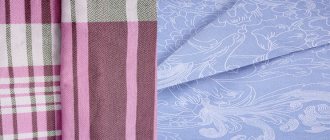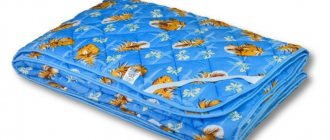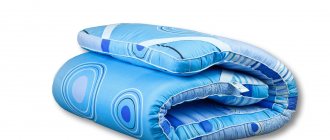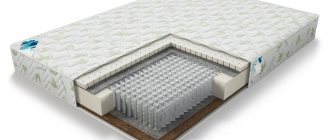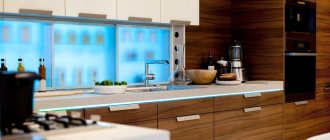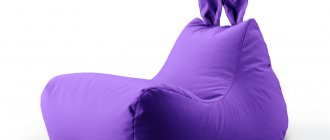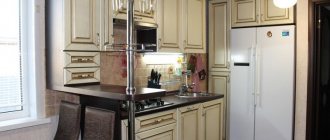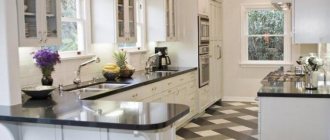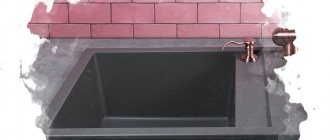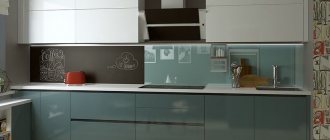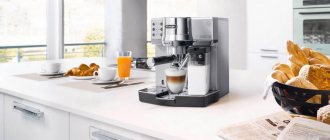Percale fabric is a unique material with unusual properties and a very wide range of applications.
Most often, the fabric is made from plant fibers - combed or untwisted cotton or linen, which makes its surface even and smooth. But synthetic derivatives can also be added to it, increasing the performance characteristics of the material. We should understand in more detail what percale fabric is and what qualities it has?
Production Features
Percale is made from long-fiber raw materials. Cotton or linen is combed out and thin, smooth threads are pulled out. They are not twisted in the usual way. The fabric is woven in a cross-shaped plain weave.
Instead of twisting, another procedure is used: treatment with an adhesive composition - sizing. Its main components:
- Potato starch.
- Animal fat. litcerin.
- Glycerol.
Sometimes other ingredients are added. Each thread is impregnated with this composition. The result is a fabric that is strong, yet soft and lightweight. Prevents yarn breakage and lint from appearing. Sizing is somewhat reminiscent of starching. But unlike a similar procedure, the sizing is not washed out of the fabric during use. The composition simply softens with each subsequent wash.
At the beginning of the twentieth century, the adhesive composition resembled liquid rubber, and its use gave the exact opposite result. The treatment resulted in the production of rubberized fabric with a specific odor. Contact with the body caused unpleasant sensations. Percale did not absorb sweat and did not allow air to pass through. Therefore, it began to be widely used in the aviation and marine industries - to create airplanes, parachutes, and sails. Thanks to innovative technologies, today customers have the opportunity to choose a gentle material that does not irritate the skin.
Description of the fabric: composition, properties, characteristics
Classic percale is a material made from long-staple combed cotton. The fabric is smooth, soft and delicate to the touch, surprisingly pleasant to the body. It retains heat, allows air to pass through, allowing the body to breathe, absorbs moisture, and does not accumulate static electricity.
The threads of the fabric fit tightly to each other, the percale does not show through. The linear density of the fabric ranges from 90 to 160 threads per 1 cm². Surface density is 72-150 g/m2 depending on the type of material.
In a nutshell about the composition
Previously, percale was made from 100% natural raw materials (long, thin fibers of flax or cotton). Later, to improve the properties, artificial threads began to be added to the composition. This is due to the fact that the natural material of dense weaving (more than 400 threads per 10 cm) is strongly wrinkled. Polyester additives can eliminate this disadvantage. But the percentage of synthetics is so insignificant that it does not affect the hygienic characteristics of the fabric.
The main producers of linen are countries where cotton cultivation has been mastered since ancient times: Pakistan, Egypt, India. In Europe, the best textile companies are located in France, Portugal, and Italy. In Russia, the main production is concentrated in Ivanovo.
Percale and its analogues
The percale material is similar in composition and consumer properties to poplin, satin and calico.
- Percale linen is a leader among its peers in terms of wear resistance and strength.
- Compared to satin, percale is harder, less smooth, and does not shine at all. Satin wins in visual appeal, but percale is more breathable, shape- and color-resistant, and wicks away moisture better.
- Compared to poplin, percale is denser and rougher to the touch. A clear advantage of percale is its low wrinkleability, while poplin requires ironing after each wash. In other characteristics, the fabrics are as similar as possible.
- Compared to coarse, rough-feeling calico, percale is famous for its smoothness, delicacy and softness, and has less weight and greater density. In other properties, high-quality calico is quite comparable to percale and successfully competes with it.
Kinds
On the textile market, percale is represented in 2 large groups. The division is determined by the scope of application.
Technical percale
Complies with GOST 12125-66. Used in the military, aviation, and chemical industries. The fabric has a low density from 65 to 120 g/m2. meter. Supplied in rolls of different widths - 110 cm and 90 cm.
The technical group of materials includes several varieties.
| Name | Peculiarities |
| Severe | One of the most popular types with low density (80g/square meter). |
| Descaled | It is subjected to special processing - removal of sizing from the fibers. The method depends on the characteristics of the adhesive composition. Desizing is necessary to strengthen the threads before weaving. |
| Impregnated | Anti-putrefactive and bactericidal impregnations are used. |
| Plain painted | Made from colored threads. |
Technical percale cannot be used for the production of bed linen: bed sheets, pillowcases. Due to the low density, the internal contents (feather, fluff) will easily penetrate through the material to the outside.
Household varieties
Percale, used in everyday life, is a high-quality, beautiful, environmentally friendly material, reminiscent of cambric. It is distinguished by pleasant tactility, softness, even and smooth texture. Its density is slightly higher than that of its technical analogue - from 115 g/square meter.
A special variety is children's percale. It is placed in a separate group due to several criteria. Firstly, the composition: bedding for babies and teenagers is made only from natural cotton. Secondly, density: this group includes canvases with a density of 102 g/m2. meter. This indicator is considered optimal for children. Thirdly, the cut width: it is usually 150 cm. This size is considered universal. It is suitable for both double bed linen sets and nursery sets.
In the specialized market, household textiles are presented in single-color and multi-colored options. According to the method of applying drawings, the following are distinguished:
- Bleached percale. The material is characterized by dazzling whiteness. The bleaching process is necessary for plain fabrics. The fact is that not only white cotton is found in nature. It can also be purple, brown, green. Therefore, the resulting threads will not be monochromatic. Bleaching allows you to obtain pure shades of color and ensures uniform coloring.
- Plain painted. The fabric is woven from colored threads. The end result is a uniform color.
- Printed. There is a pattern on one side of the surface. Previously, it was applied manually using wooden stencils. Today special printing machines are used. Using them you can apply any print – from basic polka dots to a 3D pattern.
- Jacquard. It is distinguished by a large double-sided pattern, similar to an ornament. Rapport on the base can contain more than 24 intertwined threads of different colors. The pattern is named after the inventor J.M. Jacquard. In 1804, he created a jacquard loom to produce voluminous, vibrant designs.
- Embroidered. Percale is an excellent base for embroidery. Therefore, the surface is often decorated with a variety of patterns made with cross stitch, satin stitch and other techniques.
Experts call percale the royal fabric for its elasticity, softness, and high wear resistance. In Europe, elite sets are made from it. They belong to the luxury class. The material can be used to sew underwear with a complex or non-standard cut; it looks great with frills, lace and other decor.
Percale or satin: which is better?
In terms of choosing bed linen from percale and satin, you should weigh the pros and cons in the same way as in the previous case. The main difference between the two cotton materials is that satin has a different thread weave, which is why it is smoother. Percale has a velvety feel to the touch and is more familiar to many.
Another difference lies in the features of caring for bed linen, which is easier when using satin. In terms of cost, both materials are approximately equal, but percale has a standard weave and does not change the cost. Satin can be thinner and very dense, and this changes the price.
Virtues of royal matter
The positive properties of the fabric arise from its quality characteristics. The advantages of percale include:
- Comfort. The bedding filler is securely hidden inside, and the smooth, velvety texture allows you to relax and have a good rest.
- External aesthetics. This bed looks very beautiful: snow-white pillowcases or multi-colored sheets can be complemented with decor. The color is clear, the drawings are clear and bright. The tight fit of the threads ensures uniformity.
- Inert to sunlight. Percale is not afraid of ultraviolet radiation. Products made from it do not fade, thanks to the coating with sizing.
- Resistance to deformation. Does not lose shape even after repeated washings, slight shrinkage is possible - up to 2% over the entire period of use.
- Ease. Despite its density, matter has little weight. She is practically weightless. Doesn't take up much space when stored in a closet or chest of drawers.
- Easy to care for. The material is easy to wash, dirt is quickly removed from the surface. At the same time, he is not afraid of high temperatures.
- No processing difficulties. The fabric is easy to cut, does not slip, and the cuts do not unravel or fall off.
- Antistatic. The production features made the linen not subject to electrification. Percale does not require any special treatment.
- Durability. With proper care, percale products will last 10 years or more. They can withstand up to 1000 washing cycles.
These positive aspects have led to the fact that the material is called royal and is used in the production of elite sets.
How is it different from satin and poplin?
Not only is percale woven from cotton fiber, but other popular natural fabrics have similar characteristics.
- Satin - woven from double twisted threads, pre-treated to give smoothness. The fabric is soft, pleasant on the body, and resembles silk in appearance and tactility. Satin is also used for sewing clothes and bed linen. In terms of characteristics, satin and percale are similar, but percale is considered stronger, and satin wins in terms of appearance, it has a matte sheen.
- Poplin is woven from threads of different thicknesses, producing a double-sided fabric with a textured surface. The fabric is dense, durable, pleasant to the body, wear-resistant. The main purpose is to sew bed linen, but the material is also in demand for clothing and household utensils. Poplin is somewhat coarser and thicker than percale, but is practically not inferior in other characteristics. Also read how satin differs from poplin in this material.
- Calico is a traditional plain weave, the fibers are heterogeneous, without pre-treatment. Calico has a pronounced relief surface; bed linen is sewn from it, characterized by a long service life. The material is rough, people with sensitive skin will not appreciate this set.
Calico is inferior to satin, poplin and percale in terms of appearance; it is not as decorative and is not very pleasant on the body. But satin, poplin and percale have approximately equal parameters, but percale will last the longest.
If you choose based on service life, percale wins, and if you like shine, satin is in the lead. Which is better depends on preferences and capabilities - natural cotton costs a lot. No wonder percale bed linen is considered elite.
Let's say a word about the shortcomings
No matter how good percale is, it still has disadvantages. The most significant include:
- Allergenicity. Even 100% cotton cannot guarantee safety. There is no complete certainty that the components of the adhesive composition will not cause an allergic reaction or simple skin irritation.
- Wrinkleability. Percale wrinkles very much, this is one of its differences from poplin. Adding polyester spo
actually solve this problem. But mixed fabric (with polyester additives) causes increased sweating in some people.
Sometimes there are negative reviews indicating the fragility of percale. Most likely, it's a matter of improper care. The fabric does not like strong spinning, it does not like the full cycle, it prefers a delicate mode. If all requirements are met, percale products will last a long time.
Advantages and disadvantages
Percale has a myriad of advantages, among which it is worth noting:
- strength;
- softness;
- long service life: sets of linen can be used for up to 10-15 years;
- wear resistance: the fabric does not deform, does not fade in the sun, does not fade, and is not subject to pilling;
- pleasant tactile sensations and aesthetic appearance;
- saturation, color fastness;
- hygiene, comfort in use: the material is characterized by hygroscopicity, heat-saving properties, and breathability;
- impermeability: does not allow down and feathers to escape, maintains the integrity of the stuffing.
The disadvantages of the fabric include:
- shrinkage is possible within 3%;
- The components of the dressing can cause allergic reactions on sensitive skin.
Areas of application
Percale has found its place where long-term use is important: aircraft modeling, sailing. The structure of the fabric ensures good absorption of various varnishes and adhesives. But the material is actively used in everyday life.
| Purpose | Description |
| Bed sheets | Great for winter outfits. Percale bedspreads are very warm, although they do not contain wool. The napkins are characterized by tightness due to their density. The filler is securely hidden inside. |
| Cloth | Thin varieties of fabric are used. The material is in demand for creating blouses, skirts, and dresses. |
| Houseware | Percale curtains are lightweight, they do not fade, and therefore retain their original appearance for several years. Napkins and tablecloths are easy to wash and dry quickly. |
| Aviation industry. | Previously, airplane wings were made from fabric impregnated with varnish. Now parachutes are made from it. |
| Tourism | Tents made from this fabric weigh slightly more than their synthetic counterparts. But they create a pleasant microclimate in hot or cold conditions. It never gets cold or hot in them. To create additional effects, they are sometimes coated with aluminum spray. |
| Trade | You can often find awnings and sales tents made of durable material. With their brightness they attract the attention of visitors. And their wrinkle resistance ensures a neat appearance and ease of care. |
Percale is rarely used for sewing linen for newborns and babies under 2 years of age. Bedding for this age group requires intensive washing and ironing on high heat.
Which fabric is more expensive?
Based on all of the above, it is easy to guess that percale is much more expensive than calico. However, there are some nuances here too:
- Low-quality percale with an admixture of synthetics will be slightly cheaper than 100% luxury cotton calico.
- Calico woven from high-quality cotton threads will cost more than percale made from average quality raw materials.
Naturally, without certain knowledge and sufficient experience, it is very difficult to distinguish high-quality fabric from low-quality fabric. Therefore, when choosing a set of bed linen, you need to focus on reviews from other customers and choose only conscientious manufacturers who tremble with their reputation and sell only high-quality products.
The cost of a double set of percale bed linen is 5,000-7,000 rubles, while a similar set and connections will cost from 3,000 rubles.
How to choose percale underwear
The popularity of the material has led to the appearance of numerous counterfeits on the textile market. To avoid becoming a victim of deception, you need to:
- Consider the fabric while still in the store. Look it up to the light. Percale should have no gaps between the threads.
- Check experimentally. Pull out the thread and set it on fire. The smell of burnt paper indicates its naturalness. When using synthetics, the thread will not burn, but melt.
- Ask for quality certificates. Products from trusted manufacturers must have them.
- Pay attention to the price. Good underwear cannot be cheap. You can save on percales with the help of discounts, promotions, and sales.
And most importantly, you need to make purchases in reliable stores, official retail outlets. You should avoid dubious shops and small shops.
Reviews of percale fabric
Percale receives a large number of positive reviews every day. Users cite the strength, durability, softness and beauty of fabric products as undoubted advantages. Buyers note the high cost of percale linen sets, but admit that the quality of the material speaks for itself; percale is definitely worth the money spent.
Owners are advised to pay attention to the capricious behavior of the fabric in care, to be especially careful when washing for the first time: incorrect actions lead to damage to things.
Percale is the queen of linen fabrics, it is a symbol of prestige, good wealth, gives pleasure, and attracts with the beauty of its appearance. A wide range of colors allows you to satisfy even the strictest personal preferences and enrich any interior.
Features of care
Percale cannot be called capricious in operation, but some requirements will have to be met in order to extend its durability. Basically, they relate to washing:
- Before use, it is better to wash the products in cool water (up to +20-30 degrees), without using powder or soap. This way you will maintain the richness of colors and the brightness of the design.
- Subsequent washings are possible at a temperature of +60 degrees. Mode no more than 800 rpm.
- The washing machine should be 55-60% full.
- Pillowcases and duvet covers are first turned inside out.
- We recommend detergents that do not contain chlorine, preferably liquid ones. The fabric does not like bleaching; this damages its fibers. Be sure to use fabric softener (they make it softer).
You can dry the product in a machine or in a straightened state to avoid creases and folds. Items made from percale usually do not need ironing, but if such a need arises, the soleplate of the iron should have a temperature no higher than +150 degrees.
The material does not require special storage conditions. It is not prone to yellow spots and does not absorb moisture. To add aromatic properties, you can put sachets on a shelf with bedding items.
